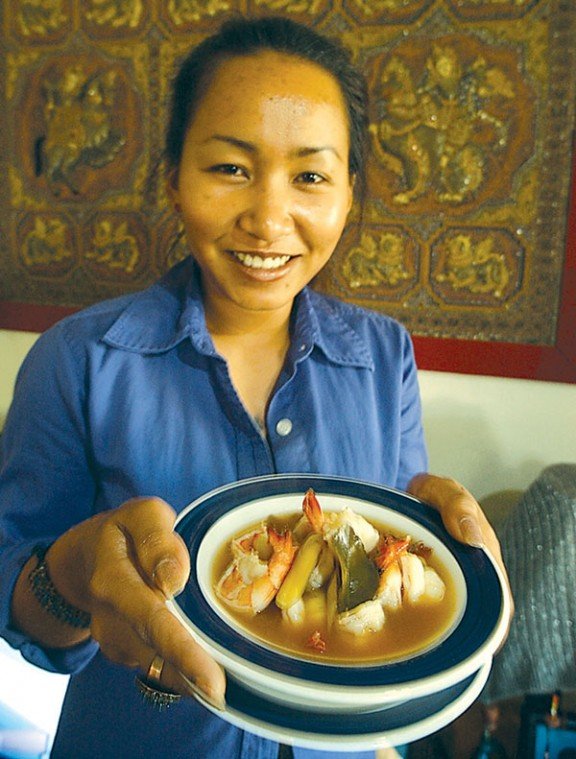Taste is much like a paint set. Sweet, sour, salty and
bitter
– the four things our tastebuds can actually sense – act as the
primary colors each gourmand has to work with.
They’re supplemented by our olfactory system, which senses
spice, pungency and fragrance, the finer shadings of our
palette.
Blend too many colors together and all you’ll get is goopy brown
chutney, but layer them and you can achieve balance, contrast and
complexity.
Taste is much like a paint set. Sweet, sour, salty and bitter – the four things our tastebuds can actually sense – act as the primary colors each gourmand has to work with.
They’re supplemented by our olfactory system, which senses spice, pungency and fragrance, the finer shadings of our palette.
Blend too many colors together and all you’ll get is goopy brown chutney, but layer them and you can achieve balance, contrast and complexity.
In the art world, Thai cuisine would be an impressionist – a Monet or Van Gogh – with swipes of raw color miraculously combined to create a stunning effect.
At once sweet and sour, rich and low-fat, it is spicy, pungent and, when authentically prepared, deliciously, earthscorchingly hot.
Influenced by a world of visitors since it’s foundation (originally known as Sukhothai when it became an independent nation in 1238), Thailand has acted as a crossroads for Asia.
It’s Chinese roots were fused with the curries brought by Indian monks at the turn of the 18th century and the hot peppers brought by Portuguese missionaries.
Local items simulated ingredients travelers found lacking. Most notably, coconut milk replaced dairy sources, leading to the sweetly distinct soups and curries found in the country today.
Notable flavors include “fish sauce, lemon grass, chilies, garlic, curry, palm sugar and tamarind,” according to Jirayu “Ann” Poeter, a cooking instructor from Thailand who now resides in Gilroy.
“Mostly the taste is fish sauce,” said Poeter. “If someone has fish sauce, they can prepare everything in their fridge Thai-style except maybe for pizza.”
Thai style itself is not homogenous. The country’s jungle-filled south is home to hot curries and fresh fish dishes, while residents of the mountainous north prefer to feast on grilled meats and fiery dipping sauces.
The nation’s middleground is dominated by orchards and rice paddies, but all of these locales are represented in the teeming streets of Bangkok.
“We have three different kinds of cooking: Home, restaurant and street,” said Poeter. “At home rice is served with almost every meal, where you have things like sour curry with green papaya or long bean and shrimp. Street stalls sell green papaya salad, pork salad and Chinese glass noodle salad. The good ones have long lines and it’s very cheap.”
Most Americans are familiar with a toned-down blend of restaurant-style cuisine (panang, tom yum and Thai coconut milk) and Palace cuisine, where complex dishes like Pad Thai are served with garnishes of flowers and carved vegetables.
“(Most Americans) can’t handle the spice that Thai people are used to,” said Poeter. She’ll teach clients to adjust a dish’s heat to their palates, but advises a few precautions when eating spicy entrees.
“Have it with just water, not beer or wine,” said Poeter. “Otherwise you’ll get too hot. And if it’s still too spicy, mix the meat into some rice to cool it down.”
Below are a few of Poeter’s recipes. Not all of the ingredients are likely familiar, and to get the taste right you’ll need to venture fairly far afield. There are no Asian specialty markets in the South Valley, but one of the best places to shop for Asian foodstuffs is the gargantuan Ranch 99 Market in San Jose, located at 5625 Snell Ave.
Extensive cooking classes are offered for tourists visiting Thailand, but you can get a similar experience a lot closer to home – in your own home, actually – by calling Poeter at (408) 846-6445 or e-mailing her at Ji**********@*****il.com.
Tom Yum
3 c. water
1/2 stalk lemongrass, chopped (1″ sections from the slimmer end)
1 med. shallot, chopped
2-3 red Thai chili peppers, dried
1/2 T. chili paste
4-5 T. fish sauce
3-4 kaffir lime leaves
3-4 slices of Thai ginger (paper-thin)
15-20 shrimp, peeled and deveined
lemon or lime juice to taste
Step 1: Mildly blacken chili peppers over a burner and very coarsely crush them using a mortar and pestle.
Step 2: Combine all ingredients except shrimp and boil 15 minutes. Add shrimp and boil three more minutes. Serve immediately.
Note: The lemongrass and chili peppers are there for flavor, not consumption.
Panang
1/2 lb. pork, chicken, shrimp or beef
1/2-1 T. chili paste (see below)
2-3 T. water
3 oz. condensed coconut milk (recommended: Chaokoh brand in the 5.6 oz
container. Use about 1/2)
2 1/4 t. palm sugar, separated
3 kaffir lime leaves, sliced very thin
1/2 T. fish sauce
dash of canola oil
Step 1: In a cast iron pan (use a small amount of canola oil to clean and
coat the pan), fry chili paste for 20-30 seconds.
Step 2: Turn on vent and splash in water followed by the condensed milk.
Cut in 2 t. palm sugar and add meat, which should be cut into bite-sized
strips.
Step 3: Once meat is browned, add fish sauce, lime leaves and 1/4 t. of
palm sugar (2-3 small slivers). Serve over rice.
Red Chili Paste
3 cloves garlic
1 t. salt
5 slices Thai ginger (paper-thin)
1/2 stalk lemongrass (the slimmer end)
1 t. kaffir lime zest
20-30 red Thai chili peppers, dried
1/2 T. shrimp paste
Step 1: Soak red peppers in water for 5-10 minutes while preparing other
ingredients. All should be very finely chopped.
Step 2: Grind with mortar and pestle or food processor. Seal and
refrigerate.
NOTE: When grinding anything spicy or acidic with a mortar and pestle, be
sure to cover the edge of the grinding bowl with your hand. Stray splashes
of liquid could hit you otherwise, and a burning eye is very popular.












